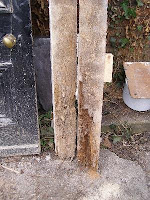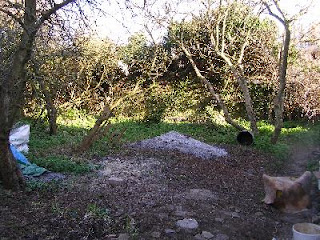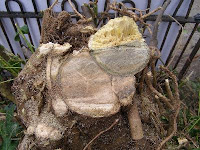 This week has seen the completion of the smooth plaster skim of all the walls and ceilings in the whole upstairs, and also down the stairway to the hall. Hopefully, next week will see the completion of the plaster in the lounge and most of the hall and kitchen. We have also replaced the old front door and frame with identical new ones (left), specially made at great expense; this was a necessary extravagance, as the old items (right) were really rotten at the base, and well past repair. The door should get painted this week, and then we can fit the door furniture; one task at home this week was to partially clean the genuine antique doctor's door knocker with vinegar.
This week has seen the completion of the smooth plaster skim of all the walls and ceilings in the whole upstairs, and also down the stairway to the hall. Hopefully, next week will see the completion of the plaster in the lounge and most of the hall and kitchen. We have also replaced the old front door and frame with identical new ones (left), specially made at great expense; this was a necessary extravagance, as the old items (right) were really rotten at the base, and well past repair. The door should get painted this week, and then we can fit the door furniture; one task at home this week was to partially clean the genuine antique doctor's door knocker with vinegar. We had a small crisis this week when the only tap in the house refused to turn off, and so I rang Steve the plumber. He suggested that I tried the rising main which I dreaded as I knew it was very stiff. Of course, when I tried to close that, it started dripping as well! Eventually, after an awful lot of water had gone down the drain, Steve came and we now have a new rising main (right, if you don't know what one looks like!) and a new tap (which will be re-used as the outdoor tap later). Steve will be back next week as the bathroom stuff has arrived and fitting will start.
On the subject of water, I have asked for a water meter (I'm glad it wasn't done before, considering the leak we had). On Thursday this week a man came to do a survey, and he expressed some surprise at being told to come here because he reckoned that no-one lived here (which is technically true at the moment) and that the house was derelict!
Last Saturday also saw a major step forward as I lit a huge bonfire. In four hours I burned all the ivy from the front of the house which was cut down last November, the branches from the pear tree which grew three inches from the house, and the buddleia, plus a good number of bits of rotten wood mostly from the joists. This was a really huge fire (viz the pile in the photo left) and the ashes were still warm on Tuesday afternoon. The result was that for the first time the whole garden was visible and accessible. The sense of space and light are a massive improvement over the damp enchanted forest which we encountered on our first visit last August.














